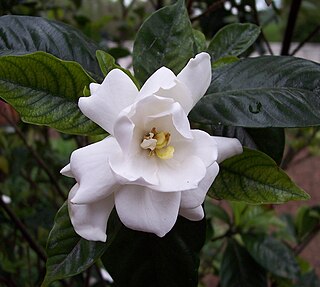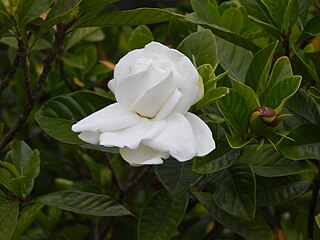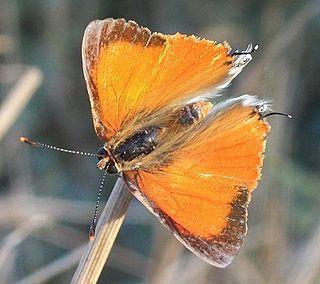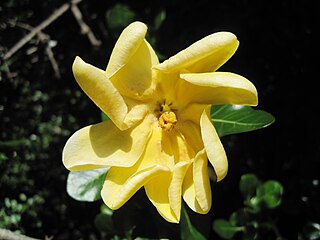
Gardenia is a genus of flowering plants in the coffee family, Rubiaceae, native to the tropical and subtropical regions of Africa, Asia, Madagascar and Pacific Islands, and Australia.

The horned screamer is a member of a small family of birds, the Anhimidae, which occurs in wetlands of tropical South America. There are three screamer species, the other two being the southern screamer and the northern screamer in the genus Chauna. They are related to the ducks, geese and swans, which are in the family Anatidae, but have bills looking more like those of game birds.

Corylus cornuta, the beaked hazelnut, is a deciduous shrubby hazel found throughout most of North America, from southern Canada south to Georgia and California. It grows in dry woodlands and at forest edges and can reach 4–8 metres (13–26 ft) tall with stems 10–25 cm thick with smooth gray bark, but it can also remain relatively small in the shade of other plants. The leaves are green, rounded oval with a pointed tip, coarsely double-toothed, 5–11 cm long and 3–8 cm broad, with hairy undersides. The male flowers are catkins that form in the fall and pollinate single female flowers the following spring to allow the fruits to mature through the summer season.

The Surinam horned frog, also known as Amazonian horned frog, is a bulky frog measuring up to 20 centimetres (7.9 in) found in the northern part of South America. It has an exceptionally wide mouth, and has horn-like projections above its eyes. Females lay up to 1,000 eggs at a time, and wrap them around aquatic plants. The frog eats other frogs, lizards, and mice. Tadpoles of the Surinam horned frog attack each other soon after being hatched.

The longhorn cowfish, also called the horned boxfish, is a species of boxfish from the family Ostraciidae, recognizable by its long horns that protrude from the front of its head, rather like those of a cow or bull. They are a resident of the Indo-Pacific region and can grow up to 50 cm (20 in) long.

The many-horned adder is a venomous viper species found in certain rocky desert areas, mostly along the Atlantic coast of southern Africa. They have characteristic tufts of "horns" above each eye. no subspecies are currently recognized.
The Albany adder is a viper species. It was previously considered a subspecies of Bitis cornuta. Its range is restricted to eastern and southern Cape Province in South Africa. Like all vipers, it is venomous.

The rhinoceros iguana is an endangered species of iguana that is primarily found on the Caribbean island of Hispaniola, shared by Haiti and the Dominican Republic. The largest of the Cyclura, they vary in length from 60 to 136 centimetres, and skin colours range from a steely grey to a dark green and even brown. Their name derives from the bony-plated pseudo-horn or outgrowth which resembles the horn of a rhinoceros on the iguana's snout.

Gardenia jasminoides, commonly known as gardenia, is an evergreen flowering plant of the coffee family Rubiaceae. It originated in Asia and is most commonly found growing wild in Vietnam, Southern China, Korea, Taiwan, Japan, Myanmar, India and Bangladesh. Wild plants range from 30 cm to 3 m high and have a rounded habit with very dense branches with opposite leaves, lanceolate-oblong, leathery or gathered in groups on the same node and by a dark green, shiny and slightly waxy surface and prominent veins.

Gardenia thunbergia is a sturdy large shrub or small tree endemic to the southern and eastern regions of South Africa and neighbouring territories such as Eswatini. It grows largely in forest or on forest margins, occurring in the Eastern Cape, Natal and Transkei in South Africa. It is densely twiggy and rigid with smooth light-grey bark, and is horticulturally valuable, being easy to grow as a strong hedge, but more usually as a specimen plant, striking in appearance and long lived. The abundant and extremely fragrant flowers are about 70 mm in diameter with long tubes only accessible to the proboscises of nocturnal hawkmoths. The leaves are smooth, shiny, whorled and entire, and clustered at the ends of branchlets. The fruit is oval, hard, woody and fibrous, about 80 mm long and about 40 mm in diameter, light grey with small raised white spots and if not eaten by large browsers or elephant, will remain on the tree for years. Its common names include forest gardenia, mutarara, tree gardenia, white gardenia and wild gardenia. In Afrikaans it is variously known as buffelsbol, stompdoring, or wildekatjiepiering.

The horned marsupial frog, originally named Nototrema cornutum Boulenger after the first describer George Albert Boulenger in 1898), is a species of frog in the family Hemiphractidae. It is an arboreal species found in Colombia, Costa Rica, Ecuador and Panama. Its natural habitats are tropical moist lowland forests and montane cloud forests. It is threatened by habitat loss.

Bradinopyga cornuta is a species of dragonfly in the family Libellulidae known by the common names horned rock-dweller and flecked wall-skimmer. It is native to much of southeastern Africa, where it is widespread. It lives in open habitat around rock pools. It is threatened by water pollution, but it is not considered to be endangered.

Didymoplexis, commonly known as crystal orchids or as 双唇兰属 , is a genus of terrestrial leafless orchids in the family Orchidaceae, about twenty species of which have been described. Orchids in this genus have swollen, fleshy rhizomes and thin, pale, upright fleshy flowering stems with resupinate, bell-shaped white or pale yellowish brown flowers. They are native to Africa, Madagascar, Southeast Asia, Australia and various islands of the Pacific.

Disa cornuta is a species of orchid found from Zimbabwe to South Africa.

Cassis cornuta, common name the horned helmet, is a species of extremely large sea snail, a marine gastropod mollusc in the family Cassidae, the helmet shells and their allies.

Deudorix dinochares, the apricot playboy, is a butterfly of the family Lycaenidae. It is found in South Africa, Madagascar, Zimbabwe, eastern Africa and south-west Arabia. In South Africa it is found from northern KwaZulu-Natal to Swaziland, Mpumalanga, Limpopo, North West and Gauteng.
Acantharachne is a genus of African orb-weaver spiders first described by Albert Tullgren in 1910.

Carlisis wahlbergi aka the Gardenia twig wilter is a Central and Southern African species of Coreidae in the order Hemiptera. The species was first described by Carl Stål, the Swedish authority on Hemiptera, and based on a specimen collected by the Swedish naturalist Johan August Wahlberg at Lake Ngami in Bechuanaland.

Gardenia volkensii, commonly known as bushveldt gardenia or Transvaal gardenia, is a species of plant in the family Rubiaceae native to southern Africa.

















